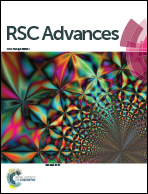DFT studies on the influence of ligation on optical and redox properties of bimetallic [Au4M2] clusters†
Abstract
Density functional theory based calculations have been employed to understand the lowest energy conformers of bare [Au4M2] and ligated [Au4M2(SCH3)6] and [Au4M2(PH3)6]2+ (where M = Au, Cu, Ag, Ni, Pd, Pt) clusters in the gas phase and in various implicit solvent media (water, DMSO and DCM). Computations predict that [Au4M2] clusters in all three charge states exist with a planar 2D-geometry, with distortion introduced by the hetero atoms. And the studies show that the ligation promotes a 2D to 3D geometrical conversion either through bridging coordination or single bond formation. The sulfur atom in the thiol ligand becomes a part of the cluster skeleton, while the PH3 forms a passivation layer around the cluster. Moreover, the presence of sulfur in the cluster skeleton increases the chemical stability of coinage metal containing clusters, while stability decreases for d8 metal containing clusters. And the PH3 passivation layer decreases the chemical stability of both coinage metal and d8 metal atom containing clusters. The computed redox behaviors show that the addition of an electron requires less energy compared to that needed for removal, and both occur with negligible geometrical reorganisation. The calculated blue shift in excitation energy values show a ligand to metal charge transfer in the –SCH3 ligated cluster. However, the red shift in wavelength is observed for the –PH3 passivated cluster, which corresponds to excitation from the HOMO to LUMO, where the orbitals have an equal contribution from the metals and ligands.
![Graphical abstract: DFT studies on the influence of ligation on optical and redox properties of bimetallic [Au4M2] clusters](/en/Image/Get?imageInfo.ImageType=GA&imageInfo.ImageIdentifier.ManuscriptID=C6RA14886G&imageInfo.ImageIdentifier.Year=2016)

 Please wait while we load your content...
Please wait while we load your content...